
Roscrea is a market town in County Tipperary, Ireland, which in 2016 had a population of 5,446. Roscrea is one of the oldest towns in Ireland, having developed around the 7th century monastery of Saint Crónán of Roscrea, parts of which remain preserved today.
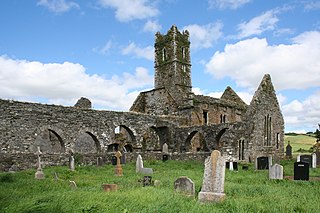
Timoleague Friary, also known as Timoleague Abbey, is a ruined medieval Franciscan friary in Timoleague, County Cork, Ireland, on the banks of the Argideen River overlooking Courtmacsherry Bay. It was built on the site of an early Christian monastic site founded by Saint Molaga, from whom the town of Timoleague derives its name. The present remains date from roughly the turn of the fourteenth century and were burnt down by British forces in the mid-seventeenth century, at which point it was an important ecclesiastical centre that engaged in significant trade with Spain.

Quin Abbey, in Quin, County Clare, Ireland, was built between 1402 and 1433 by Sioda Cam MacNamara, for Fathers Purcell and Mooney, friars of the Franciscan order. Although mostly roofless, the structure of the abbey is relatively well preserved. There is an intact cloister, and many other surviving architectural features make the friary of significant historical value.

The Ross Errilly Friary is a medieval Franciscan friary located about a mile to the northwest of Headford, County Galway, Ireland. It is a National Monument of Ireland and among the best-preserved medieval monastic sites in the country. Though usually referred to by locals as "Ross Abbey," this is not technically correct as the community never had an abbot.

Kilconnell or Killconnell Abbey(Irish: Mainistir Chill Chonaill) is a ruined medieval Franciscan friary located in Kilconnell, County Galway, Ireland.

The French Church, a former Franciscan Friary and also known as Greyfriars Abbey it was built in 1241 on what is now Greyfriars and Baileys New Street, Waterford. At the entrance to the ancient church stands a monument to Luke Wadding, the famous 17th century Waterford born priest. This friary was one of the first to be built in Ireland, being founded by the Anglo-Norman Knight Sir Hugh Purcell.

Moor Abbey is a ruined medieval Franciscan friary in Galbally, County Tipperary, Ireland, on the banks of the River Aherlow. Originally founded in the 13th century, the surviving ruins date from the late 15th century. The abbey was burnt down by British forces in 1569.
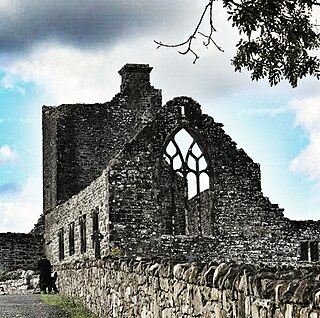
Creevelea Abbey is a medieval Franciscan friary and National Monument located in Dromahair, County Leitrim, Ireland. Creeveley Abbey is now in use for as a grave yard.

Strade Abbey is a former Franciscan/Dominican monastery and National Monument located in County Mayo, Ireland.
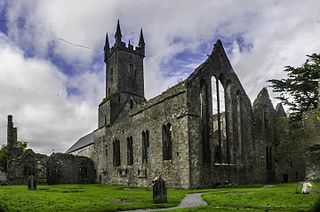
Ennis Friary was a Franciscan friary in the town of Ennis, County Clare, Ireland. It was established in the middle of the 13th century by the ruling O'Brien dynasty who supported it for most of its existence. Following the suppression of the monasteries in the 16th century, the friary continued to function for a while despite the loss of its lands. In the early 17th century, the buildings were handed over to the Church of Ireland as a place of worship. It was used as such until the late 19th century. After the construction of a new Church of Ireland building, the friary fell into ruin. Managed by the Office of Public Works since the late 19th century, it was formally returned to the Franciscan Order in 1969.

Lislaughtin Abbey is a medieval Franciscan friary and National Monument located in County Kerry, Ireland.

Ardfert Abbey, also known as Ardfert Friary, is a ruined medieval Franciscan friary and National Monument in Ardfert, County Kerry, Ireland. It is thought to be built on the site of an early Christian monastic site founded by Brendan the Navigator. The present remains date from the mid-thirteenth century, with the residential tower being added in the 15th century. The friary was dissolved in 1584.

Portumna Abbey is a medieval Cistercian friary and National Monument located in Portumna, Ireland.

Kinalehin Friary, originally a medieval charterhouse or Carthusian monastery and later a Franciscan friary, is a National Monument located in County Galway, Ireland.
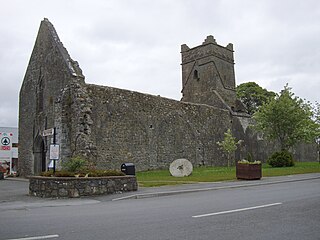
Dunmore Abbey is a medieval Augustinian friary and National Monument located in County Galway, Ireland.
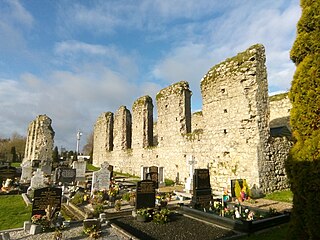
Clane Friary, also called Clane Abbey, is a former friary of the Order of Friars Minor Conventual located in Clane, Ireland.

Askeaton Abbey or Askeaton Friary is a former Franciscan monastery and National Monument located in County Limerick, Ireland.





















